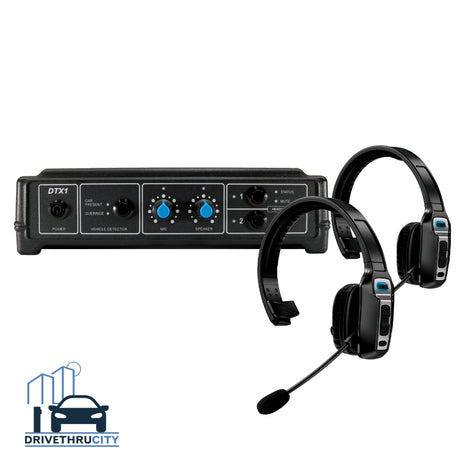Drive-Thru Beverages: Your Guide to Brewing Success with DTX1 Headset Intercom System
Publicado por XMOD LLC en

The Perfect Cup is Just a Pull Away: The drive-thru beverage market is hotter than ever, thanks to convenience-seeking customers and a cultural shift towards mobile ordering. Whether you're dreaming of a coffee haven, a boba tea bonanza, or a sparkling soda stop, this guide will help you navigate the road to success, powered by the efficiency and clarity of the DTX1 Wireless Headset Intercom System.
1. Research & Refine:
Know your market: Who are you serving? What are their needs and preferences? Analyze the competition to find your unique niche.
Craft your blueprint: Create a detailed business plan outlining your vision, strategies, and financial projections. This will be your roadmap to success and attract potential investors.
2. Permits & Licenses:
Stay compliant: Research and obtain all necessary permits and licenses, especially if you plan to offer alcohol. Don't get caught in a regulatory roadblock!
3. Location, Location, Location:
Drive traffic, not just cars: High visibility, easy access, and ample parking are essential. Consider existing drive-thrus for inspiration and potential acquisition.
4. Gear Up for Success:
Invest wisely: Secure reliable equipment like commercial refrigerators and a user-friendly POS system. Don't forget eye-catching signage and delicious inventory!
Build your team: Hire friendly, efficient staff and train them on drive-thru best practices.
Embrace technology: Invest in the DTX1 Wireless Headset Intercom System for crystal-clear communication, increased accuracy, and improved order processing speed.
Boost Your Business with DTX1:
Reduce order errors: Crystal-clear audio eliminates miscommunications, leading to fewer remakes and happier customers. Studies show a 20% reduction in order errors with clear intercom systems like DTX1.
Speed up service: DTX1 streamlines communication, allowing staff to take orders faster and get customers on their way. Increase customer throughput by up to 15% with efficient order taking.
Enhance employee satisfaction: Frustration caused by unclear communication disappears with DTX1. Happy employees provide better customer service, leading to higher customer satisfaction and loyalty.
Improve safety: Hands-free communication allows staff to focus on their tasks and navigate the drive-thru safely.
Bonus Tip: Observe the competition! Learn from their successes and failures to optimize your own drive-thru experience.
Real-Life Inspiration:
Jasmine Diedrich, Diedrich Espresso: Opting for existing drive-thrus allowed her to learn, adapt, and grow her business to 12 locations.
Icy Mountain Water: Their drive-thru caters to customers seeking convenience for reverse osmosis water, ice, and CO2 canisters.
Remember: Starting a drive-thru beverage business requires dedication and planning, but the rewards are sweet. With the right strategy, a passionate team, the DTX1 intercom as your communication champion, and these helpful tips, you'll be brewing success in no time!
Drive-Thru Domination: Stats on How It Boosts QSR Business
The drive-thru has become a crucial element of the QSR (Quick Service Restaurant) landscape, and its impact on business growth is undeniable. Here are some key statistics showcasing its rise and impact over the past 30 years:
Sales Growth:
- Dominant Channel: Drive-thrus currently generate 60-70% of all sales for QSR chains in the US, a significant increase from past decades. This trend is expected to continue. (Source: National Restaurant Association, QSR magazine)
- Revenue Engine: PJ's Coffee, for example, saw a 53.4% increase in revenue at locations with drive-thrus compared to those without. (Source: QSR magazine)
- Pandemic Powerhouse: During the pandemic, drive-thru sales surged as consumers sought convenient and contactless options. QSRs with strong drive-thru presence weathered the storm better. (Source: National Restaurant Association)
Customer Preferences:
- Top Choice: Studies show 70-80% of QSR customers prefer drive-thrus for their speed, convenience, and ease of use. (Source: Armagard Ltd., QSR magazine)
- Time Crunch: Busy lifestyles and increased demand for on-the-go dining contribute to the drive-thru's popularity.
Technology & Efficiency:
- Digital Drive-Thrus: Adoption of digital menu boards and order kiosks has increased average order value by up to 8% by suggesting add-ons and promoting deals. (Source: Armagard Ltd.)
- Speed is King: Faster service is critical in drive-thrus. Technology streamlines ordering, payment, and food preparation, leading to reduced wait times and higher customer satisfaction. (Source: QSR magazine)
Personalization & Future Trends:
- Untapped Potential: QSRs are starting to personalize drive-thru experiences based on customer data, location, and order history, offering further sales potential. (Source: Dynamic Yield)
- Mobile Integration: Mobile apps and loyalty programs integrated with drive-thrus will drive customer engagement and targeted promotions, further boosting sales.
Overall, the drive-thru's impact on QSR business is undeniable. Its convenience, efficiency, and adaptability to changing consumer needs make it a key growth driver for the industry.
Please note: These statistics are primarily based on US data, but similar trends are observed in other countries with developed QSR markets.
While the traditional drive-thru system might not be directly applicable to food trucks due to their mobile nature, the concept of offering a quick and convenient ordering and pick-up system can definitely be adapted and benefit the food truck business. Here are some ways how:
Increased Efficiency:
- Mobile Ordering Apps: Develop a mobile app where customers can browse the menu, order in advance, and pay online. This reduces lines, allows for faster service, and increases order accuracy.
- Pre-Order & Pick-Up Window: Offer dedicated time slots for pre-ordered pick-up, separate from the main line, to streamline the process and reduce wait times.
- Self-Service Kiosks: If feasible, consider setting up a self-service kiosk where customers can place and pay for their orders, further reducing staff workload and wait times.
Improved Customer Experience:
- Reduced Wait Times: By offering pre-ordering and dedicated pick-up options, you ensure customers don't have to wait in long lines, especially during peak hours.
- Convenience: Customers can order and pay on their own terms, without having to shout over the truck window or wait in line. This caters to busy lifestyles and those who prefer contactless interactions.
- Customization: Mobile apps can allow for customization options, which can enhance customer satisfaction and encourage repeat business.
Additional Benefits:
- Increased Sales: Faster service and reduced wait times can lead to more customers served per hour, translating to higher sales.
- Data & Insights: Mobile app data can provide valuable insights into customer preferences, peak times, and popular items, allowing you to optimize your menu and offerings.
- Marketing & Promotions: Utilize the app to send targeted promotions, loyalty rewards, and updates, fostering customer engagement and driving repeat business.
Overall, adapting elements of the drive-thru system can be a valuable strategy for food trucks, but careful planning, cost analysis, and execution are crucial for success.
The potential benefit of using a totally wireless drive-thru intercom system for food trucks
Potential Benefits:
- Improved Communication: A clear and reliable intercom system can facilitate better communication between staff and customers, especially in noisy environments. This can lead to faster order processing, fewer mistakes, and a smoother overall experience.
- Increased Order Value: Upselling and suggesting additional items is easier with two-way communication, potentially increasing average order value.
- Enhanced Brand Image: A modern and efficient ordering system can contribute to a positive brand perception, attracting more customers.
- Reduced Wait Times: If used effectively, an intercom system can help manage order flow and reduce wait times, which is crucial for customer satisfaction.
FOOD TRUCKS in USA
Number of Businesses:
- IBISWorld: As of 2023, there are 47,033 Food Trucks businesses in the US.
- FoodParks.io: Estimates between 35,000 and 40,000 food trucks currently operating within the US.
Number of Operating Trucks:
- InsuranceBee: Estimates over 35,500 food trucks currently operating in the US.
These numbers offer a range and highlight the difficulty of getting a precise figure. It's important to note that these estimates might not include unlicensed or unregistered food trucks operating under the radar.
Additionally, keep in mind that the number of food trucks can vary depending on:
- Definition of "food truck": Does it include carts, trailers, and other mobile food vendors?
- Data sources: Different sources use different methodologies and might have varying levels of accuracy.
- Licensing requirements: Regulations and licensing procedures vary across states and municipalities.
QSR (Quick Service Restaurant) businesses in the USA
Determining the exact number of registered QSR (Quick Service Restaurant) businesses in the USA is challenging due to several factors:
Different Definitions:
- Industry vs. Franchise: The definition of "QSR" can vary depending on whether it refers to the broader industry or specific franchised chains.
- Government Categorization: Government agencies might categorize QSRs under different codes, making it difficult to isolate the exact number.
Data Sources:
- Private vs. Public: Comprehensive data on registered businesses is often held by private companies and can be expensive to access.
- Local vs. National: Data might be available at the local level but not aggregated nationally, requiring extensive research across different sources.
Dynamic Landscape:
- New Businesses: New QSRs open and close frequently, making it difficult to maintain an accurate count.
- Franchises vs. Independents: Tracking both franchised and independent QSRs can be complex due to their differing structures.
However, here are some resources and estimates to provide an idea:
- IBISWorld: Estimates 33,725 Quick Service Restaurants (NAICS code 72221) in the US as of 2023. This might not include all franchised or independent QSRs.
- National Restaurant Association: Provides industry reports and data but doesn't offer a specific count of registered QSR businesses.
- Franchise Business Review: Tracks franchise data and lists over 500 QSR franchise brands operating in the US. This doesn't include independent businesses.
Overall, while an exact figure is elusive, the available resources indicate a significant number of registered QSR businesses in the USA. Remember that the actual number might be higher due to the limitations mentioned above.
list of some of the largest franchises by store count, alongside their estimated global locations:
| **Franchise Name | Estimated Stores (as of 2024)** |
|---|---|
| McDonald's | 40,000+ |
| Subway | 36,592 |
| Starbucks | 33,000+ |
| KFC | 25,000+ |
| Pizza Hut | 18,100+ |
| Dunkin' Donuts | 11,300+ |
| Domino's Pizza | 17,100+ |
| Burger King | 18,700+ |
| Taco Bell | 7,200+ |
| Wendy's | 6,800+ |
Please note:
- These are estimated figures, and actual store counts might vary depending on sources and definitions.
- This list focuses on global presence, not necessarily financial performance or brand recognition.
- Other notable franchises like Chick-fil-A, Chipotle, and Jollibee might not have as many stores globally but hold significant importance in specific regions.
Additional factors to consider when evaluating "importance" of franchises:
- Revenue: Annual revenue generated by the franchise chain.
- Brand Recognition: Global awareness and perception of the brand.
- Market Share: Percentage of the fast-food market captured by the franchise.
- Customer Satisfaction: Ratings and reviews from customers.
- Employee Satisfaction: Working conditions and employee engagement within the franchise.
- Innovation: The franchise's ability to adapt and introduce new offerings.
A significant number of small, independent QSR businesses operate across the USA. Their exact number and distribution by state remain challenging to quantify due to data limitations and dynamic nature of the industry.
Unfortunately, it's impossible to provide an accurate and complete list of the estimated number of small, independent QSR businesses (Quick Service Restaurants) in the USA, broken down by state, for several reasons:
Data Limitations:
- No Centralized Database: There's no single entity collecting and maintaining data on all small businesses, including QSRs, across the US.
- Varying Definitions: Different sources might define "small business" and "QSR" differently, making comparisons challenging.
- Licensing Differences: Licensing requirements and procedures vary across states and municipalities, making national data collection even more complex.
Alternative Estimates:
While a concrete list isn't feasible, here are some resources and estimates that offer insights:
- IBISWorld: Estimates 33,725 Quick Service Restaurants (NAICS code 72221) in the US as of 2023. This includes both franchises and independents.
- SBA (Small Business Administration): Provides data on the number of small businesses in various industries, but doesn't offer a separate category for small QSRs.
- State-Level Data: Some states publish data on small businesses within their jurisdiction, but categorizations and definitions might vary.
Additional Considerations:
- Unlicensed Businesses: The number might be higher if considering unregistered or unlicensed QSRs operating under the radar.
- Constant Fluctuation: New businesses open and close frequently, making it difficult to maintain a precise figure.



